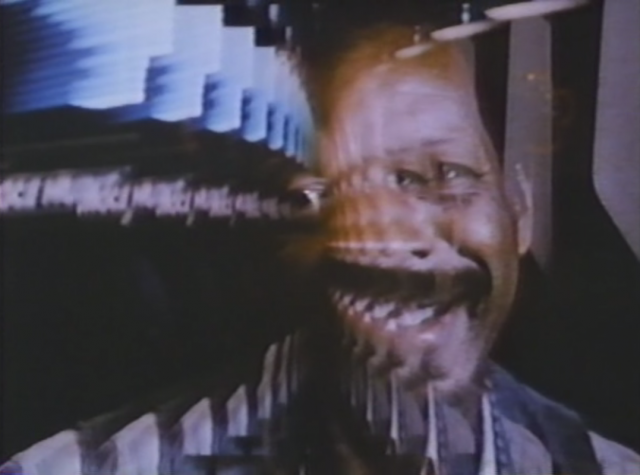
Shirley Clarke’s portrait of free jazz legend Ornette Coleman is back in a beautiful new 35mm restoration
ORNETTE: MADE IN AMERICA (Shirley Clarke, 1985)
IFC Center
323 Sixth Ave. at West Third St.
Opens Friday, August 31
212-924-7771
www.ifccenter.com
www.milestonefilms.com
 In September 1983, innovative saxophonist and Fort Worth, Texas, native Ornette Coleman received a key to the city of his hometown and then helped open the new Caravan of Dreams arts center by performing the world premiere of “Skies of America,” a specially commissioned work that teamed Coleman and his band, Prime Time, with the Forth Worth Symphony. Director Shirley Clarke uses this celebratory event as the central focus of her 1985 documentary, Ornette: Made in America, which is being rereleased in a beautiful new 35mm restoration overseen by Milestone Films as part of its continuing Project Shirley, which began earlier this year with a dazzling new print of Clarke’s 1962 film about jazz and drugs, The Connection. In Ornette: Made in America, Clarke combines footage she shot of Coleman back in the 1960s for a never-completed film with new material that offers an inside look at Coleman and his relationship with his son, Denardo, a musical prodigy who has played drums with his father for decades, since he was a young boy. Clarke also includes staged scenes of young versions of Coleman wandering through his old neighborhood of Fort Worth, then turning to the camera to deliver determined stares, in addition to shots of a theater troupe dancing joyously down the street, Coleman performing through the years in San Francisco, New York City, and Nigeria, and interactions with such prominent figures as music critic Robert Palmer, artist Brion Gysin, writer William S. Burroughs, and architect Buckminster Fuller, who had a profound influence on Coleman’s unique free jazz sound. “As Buck says, you can’t see outside yourself, but we do have imagination,” Coleman explains inside a geodesic dome. “The expression of all individual imagination is what I call harmolodics, and each being’s imagination is their own unison, and there are as many unisons as there are stars in the sky.” Clarke puts the film together like one of Coleman’s free jazz compositions, filled with harmolodics, going from black-and-white to color and back again, cutting between interviews and live performances, moving from relaxing images to propulsive moments, and regularly bordering on the goofy, including talking heads in an animated television set, brief explanatory text in marquee scrolls, and shots of Coleman riding a spacecraft over the surface of the moon. Despite such silliness, Ornette: Made in America is a thrilling portrait of a national treasure, a one-of-a-kind musician who is still playing his unique brand of music in his eighties.
In September 1983, innovative saxophonist and Fort Worth, Texas, native Ornette Coleman received a key to the city of his hometown and then helped open the new Caravan of Dreams arts center by performing the world premiere of “Skies of America,” a specially commissioned work that teamed Coleman and his band, Prime Time, with the Forth Worth Symphony. Director Shirley Clarke uses this celebratory event as the central focus of her 1985 documentary, Ornette: Made in America, which is being rereleased in a beautiful new 35mm restoration overseen by Milestone Films as part of its continuing Project Shirley, which began earlier this year with a dazzling new print of Clarke’s 1962 film about jazz and drugs, The Connection. In Ornette: Made in America, Clarke combines footage she shot of Coleman back in the 1960s for a never-completed film with new material that offers an inside look at Coleman and his relationship with his son, Denardo, a musical prodigy who has played drums with his father for decades, since he was a young boy. Clarke also includes staged scenes of young versions of Coleman wandering through his old neighborhood of Fort Worth, then turning to the camera to deliver determined stares, in addition to shots of a theater troupe dancing joyously down the street, Coleman performing through the years in San Francisco, New York City, and Nigeria, and interactions with such prominent figures as music critic Robert Palmer, artist Brion Gysin, writer William S. Burroughs, and architect Buckminster Fuller, who had a profound influence on Coleman’s unique free jazz sound. “As Buck says, you can’t see outside yourself, but we do have imagination,” Coleman explains inside a geodesic dome. “The expression of all individual imagination is what I call harmolodics, and each being’s imagination is their own unison, and there are as many unisons as there are stars in the sky.” Clarke puts the film together like one of Coleman’s free jazz compositions, filled with harmolodics, going from black-and-white to color and back again, cutting between interviews and live performances, moving from relaxing images to propulsive moments, and regularly bordering on the goofy, including talking heads in an animated television set, brief explanatory text in marquee scrolls, and shots of Coleman riding a spacecraft over the surface of the moon. Despite such silliness, Ornette: Made in America is a thrilling portrait of a national treasure, a one-of-a-kind musician who is still playing his unique brand of music in his eighties.